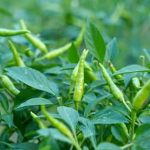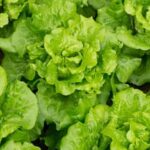Bucket gardening is a convenient and flexible way to grow your own vegetables, even if you have limited space. In this article, we will explore the best vegetables for bucket gardening, perfect for beginners looking to embark on their gardening journey. Whether you have a small balcony, patio, or simply want to add greenery to your home, bucket gardening offers a simple and accessible solution.
One of the key advantages of bucket gardening is the ability to control the growing environment for your plants. This method allows you to easily customize the soil type, drainage, and sunlight exposure needed for specific vegetables. By selecting the right containers and following essential tips for successful growth, you can enjoy a bountiful harvest no matter where you live.
In this beginner’s guide to bucket gardening, we will cover everything from selecting the right containers and essential tools to creative ways to arrange your garden. With these helpful tips in mind, you’ll be well-prepared to start growing your favorite vegetables in buckets and experience the joys of homegrown produce firsthand.
Benefits of Bucket Gardening Over Traditional Gardening Methods
Bucket gardening offers several benefits over traditional gardening methods, making it an enticing option for both beginners and experienced gardeners alike. One of the primary advantages of bucket gardening is its flexibility and versatility.
With bucket gardening, you can easily move your plants around to optimize sunlight exposure or protect them from harsh weather conditions. This portability also allows individuals with limited space, such as those living in apartments or condos, to enjoy gardening without a traditional backyard or plot of land.
In addition to its flexibility, bucket gardening is also known for its efficient use of resources. By growing vegetables in containers, you can conserve water by ensuring that moisture is retained within the confined space of the bucket. This can be especially beneficial in regions where water conservation is a concern. Furthermore, the controlled environment of a bucket allows for easier monitoring and management of soil quality, ensuring that your plants receive the necessary nutrients for healthy growth.
Moreover, another advantage of bucket gardening is its accessibility to individuals with physical limitations or mobility issues. The convenience of tending to plants at a manageable height reduces strain on the back and knees, making it an ideal option for those who may have difficulty with traditional ground-level gardening. Additionally, the compact nature of container gardening means less bending over and kneeling, providing a more comfortable experience overall while still reaping the rewards of fresh homegrown produce.
Selecting the Right Containers for Bucket Gardening
Size
When selecting containers for bucket gardening, opt for larger buckets that provide ample space for root development. Ideally, choose containers that are at least 5 gallons in size to accommodate the growth of vegetables such as tomatoes, peppers, and cucumbers. Larger containers also allow for better moisture retention and stability for taller plants.
Material
The material of the container can also affect the overall health of your vegetable plants. Plastic buckets are a popular choice for bucket gardening due to their affordability and durability. However, be mindful of using food-grade plastic buckets to avoid any potential leaching of harmful chemicals into your soil. Additionally, consider using light-colored containers to prevent overheating during hot summer months.
Drainage
Proper drainage is essential for preventing waterlogged soil and root rot in bucket gardening. Look for containers with pre-drilled drainage holes at the bottom to ensure excess water can escape freely. Alternatively, you can drill your own drainage holes if needed. Elevating your buckets on bricks or blocks can also aid in drainage and prevent water from pooling around the roots of your vegetables.
By carefully selecting the right containers for bucket gardening based on size, material, and drainage capabilities, you can create an optimal growing environment for the best vegetables for bucket gardening. Remember that providing adequate space and ventilation is key to promoting healthy root development and maximizing yield in your bucket garden setup.
Essential Tools and Materials Needed for Bucket Gardening
Bucket gardening is an excellent way to grow your own fresh vegetables even in a limited space or urban environment. To get started with bucket gardening, you will need a few essential tools and materials to ensure the success of your vegetable plants.
First and foremost, you will need suitable buckets or containers for growing your vegetables. Opt for food-grade plastic buckets that are at least 5 gallons in size, as they provide ample space for root growth. Ensure that the buckets have drainage holes at the bottom to prevent waterlogged soil, which can lead to root rot.
In addition to buckets, you will need high-quality potting soil for planting your vegetables. Select a well-draining potting mix that is rich in organic matter and nutrients to support healthy plant growth. Avoid using garden soil, as it may compact in containers and hinder root development. Adding compost to the potting mix can further enrich the soil and promote robust vegetable growth.
| Essential Tools and Materials | Benefits |
|---|---|
| Suitable buckets or containers | Provide ample space for root growth |
| High-quality potting soil | Well-draining and rich in nutrients |
Top 5 Best Vegetables for Bucket Gardening
Bucket gardening is a fantastic option for those who are limited on space or want to have more control over their growing environment. One of the best aspects of bucket gardening is the versatility it offers in terms of what you can grow.
When deciding which vegetables to plant in your bucket garden, consider factors such as the size of the plant, the depth of the root system, and the amount of sunlight needed. Here are five of the best vegetables for bucket gardening:
- Tomatoes: Tomatoes thrive in container gardens and can be grown successfully in buckets. Choose compact varieties like cherry tomatoes or determinate types that do not require staking.
- Peppers: Bell peppers, hot peppers, and chili peppers all do well in containers. They require regular watering and plenty of sunlight to flourish.
- Leafy Greens: Vegetables like lettuce, spinach, kale, and Swiss chard are excellent choices for bucket gardening. These greens have shallow root systems and can be harvested continuously throughout the growing season.
When selecting vegetables for your bucket garden, consider the space available and how many plants you want to grow in each container. It’s essential to provide adequate drainage to prevent waterlogged soil, as this can lead to root rot and other issues. Additionally, regular fertilization is crucial for maintaining healthy plants in a confined space like a bucket garden.
Incorporating a variety of vegetables into your bucket garden can provide you with fresh produce throughout the growing season. Experiment with different combinations and planting strategies to maximize your harvest potential. With proper care and maintenance, you can enjoy a bountiful harvest of your favorite vegetables grown right at home through bucket gardening.
Tips for Successful Growth and Maintenance of Vegetables in Buckets
Growing vegetables in buckets can be a rewarding and convenient way to cultivate your own fresh produce, even in limited spaces. To ensure successful growth and maintenance of your vegetable bucket garden, there are several key tips to keep in mind:
- Proper Drainage: Ensure that your buckets have adequate drainage holes at the bottom to prevent waterlogging, which can lead to root rot. You can also add a layer of gravel or small rocks at the bottom of the bucket to improve drainage.
- Quality Soil: Use high-quality potting mix specifically designed for container gardening to provide your vegetables with the necessary nutrients for healthy growth. Regularly check and replenish the soil as needed to maintain optimal conditions.
- Watering Routine: Consistent watering is essential for vegetable plants grown in buckets, as they can dry out more quickly than those planted in traditional ground beds. Keep an eye on moisture levels and adjust your watering schedule accordingly, being careful not to overwater.
In addition to these fundamental tips, selecting the right vegetable varieties for bucket gardening is crucial for a successful harvest. Here are some of the best vegetables suited for thriving in containers:
- Tomatoes: Compact varieties like cherry tomatoes or determinate types are ideal for growing in buckets. Provide support structures like cages or stakes as they grow upwards.
- Carrots: A versatile root vegetable that can grow well in deeper buckets. Choose cylindrical or shorter carrot varieties for better results.
- Peppers: Bell peppers, chili peppers, and other sweet or hot pepper varieties do well in containers. Make sure they receive plenty of sunlight for optimal fruit production.
By following these tips and selecting the best vegetables for bucket gardening, you can enjoy a bountiful harvest of fresh produce right at your fingertips. With proper care and attention, your bucket garden can yield delicious vegetables throughout the growing season.
Creative Ways to Arrange Your Bucket Garden
Bucket gardening offers a versatile way to grow vegetables even in small spaces like patios, balconies, or even indoors. When it comes to setting up your bucket garden, there are endless creative ways to arrange your containers to maximize space and aesthetics. One popular method is vertical gardening where buckets are stacked on top of each other to create a towering display of varying greenery.
Another creative approach is to mix and match different sizes and colors of buckets for an eclectic look. Using different heights of buckets can also add visual interest to your garden arrangement. Additionally, consider painting or decorating your buckets to add a personalized touch to your gardening space.
For a more organized layout, you can use shelving units or hanging hooks to suspend the buckets at different levels. This not only saves space but also allows for easier access and maintenance of your vegetable plants. Whatever arrangement you choose, make sure each bucket has adequate drainage holes at the bottom and enough space for the roots to grow properly.
| Creative Arrangement Ideas | Benefits |
|---|---|
| Vertical Gardening | Maximizes space utilization |
| Mixing Bucket Sizes/Colors | Adds visual interest |
| Using Shelving Units/Hanging Hooks | Saves space and facilitates maintenance |
Troubleshooting Common Issues in Bucket Gardening
When it comes to bucket gardening, like any other form of gardening, there can be some common issues that may arise. It is important to be prepared and know how to troubleshoot these problems to ensure the health and success of your vegetable plants. One common issue that gardeners may encounter is overwatering or underwatering their plants.
This can lead to root rot or wilting, respectively. To avoid this, make sure to check the moisture levels regularly and adjust your watering schedule accordingly.
Another common issue in bucket gardening is nutrient deficiencies. Since the plants are confined to a smaller space, they may deplete the nutrients in the soil more quickly than plants grown in a traditional garden bed. To combat this issue, consider using a balanced fertilizer or adding compost to replenish the nutrients in the soil. Additionally, keep an eye out for signs of yellowing leaves or stunted growth, which could indicate a lack of essential nutrients.
Pests can also be a problem when it comes to bucket gardening. Aphids, caterpillars, and slugs are just a few of the pests that may target your vegetable plants.
To prevent infestations, regularly inspect your plants for any sign of pests and consider using natural remedies such as neem oil or insecticidal soap to keep them at bay. By staying proactive and addressing these common issues promptly, you can ensure a thriving bucket garden filled with the best vegetables for bucket gardening.
Conclusion
In conclusion, bucket gardening offers a convenient and flexible solution for growing your own fresh vegetables, even in limited spaces. By selecting the right containers, tools, and materials, along with choosing the best vegetables for bucket gardening like tomatoes, peppers, and lettuce, you can easily enjoy a bountiful harvest right at your fingertips. The benefits of bucket gardening over traditional methods are numerous, from easier maintenance to better control over soil quality and nutrients.
Furthermore, with the tips provided for successful growth and maintenance of vegetables in buckets, you can ensure a thriving garden throughout the growing season. Whether you’re a beginner or have some experience in gardening, bucket gardening can be a rewarding and enjoyable experience. Additionally, exploring creative ways to arrange your bucket garden not only adds aesthetic appeal but also maximizes space efficiency.
Overall, embracing the convenience and flexibility of bucket gardening opens up new possibilities for urban dwellers, apartment residents, or anyone looking to expand their gardening horizons. With proper planning and care, you can cultivate a diverse array of delicious vegetables right on your balcony or patio. So why wait? Start your bucket garden today and reap the rewards of homegrown produce all season long.
Frequently Asked Questions
What Is the Easiest Vegetable to Grow in a Bucket?
One of the easiest vegetables to grow in a bucket is lettuce. Lettuce grows relatively quickly and does not require a lot of space or deep soil. It can thrive in a smaller container, making it ideal for beginners or those with limited space.
What Vegetables Do Well in 5 Gallon Buckets?
Several vegetables do well in 5-gallon buckets, including tomatoes, peppers, cucumbers, and beans. Tomatoes especially flourish in this size container as long as they receive sufficient sunlight, water, and support as they grow. Peppers also thrive in buckets and are relatively low maintenance.
What Veg Is Best for Container Gardening?
When it comes to container gardening, herbs like basil, mint, and chives are some of the best options. They don’t require a lot of space to grow and can even be grown indoors if needed. Herbs also add flavor to your dishes and can be harvested continuously throughout the growing season.

If you’re looking to get into vegetable gardening, or are just looking for some tips on how to make your current garden better, then you’ve come to the right place! My name is Ethel and I have been gardening for years. In this blog, I’m going to share with you some of my best tips on how to create a successful vegetable garden.





